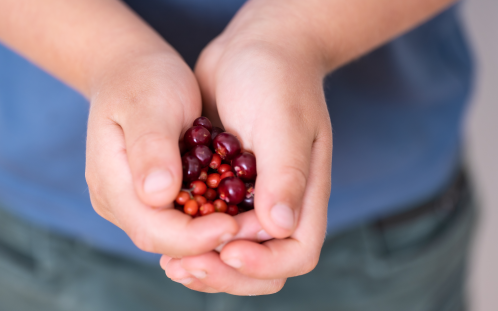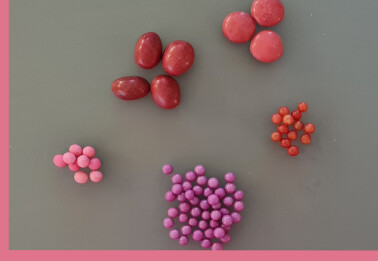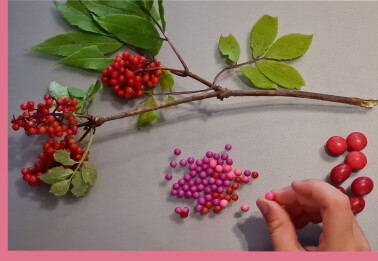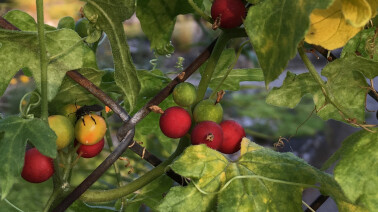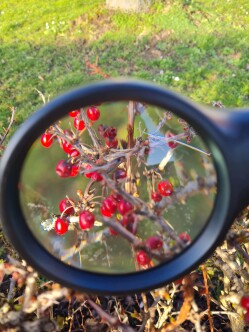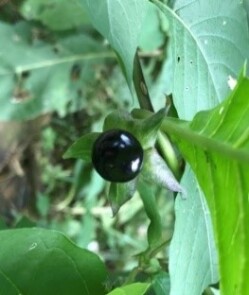Red berries, black berries
When is it fine to nibble and when is it dangerous?
Red berries in particular hold a magical allure for young children
Small quantities of red berries – edible or poisonous – do not pose a great risk of poisoning
There is a long list of plants in Switzerland with red (mock) berries. Some berries are edible, others are inedible or poisonous. However, the experience of Tox Info Suisse has shown that accidents with red berries do not usually present a big risk for young children.
The latest literature also confirms this and corresponds to the experiences of other European poison centres. The majority of red berries are only slightly toxic, do not taste good or incite a strong burning sensation in the mouth, which means that no child voluntarily consumes any more of the berries.
It is not essential to identify the plant according to its specific Latin name. However, for parents of potential repeat offenders (i.e. all small children), it is sensible to become familiar with the plants in your local area and their toxicity.
5 red berry rule:
Consuming up to 5 red berries from native plants will not trigger any severe symptoms of poisoning even in young children.
- There is no need to worry about anything more than mild gastrointestinal symptoms.
- It is not imperative to identify the plant.
There’s always an exception to the rule: “Red bryony” (Bryonia dioica)
Red bryony: The rambling climbing plant can be found, for example, on fences of parks and public gardens.
Consuming single red berries from red bryony can cause severe gastrointestinal symptoms, in some cases with bloody diarrhoea. This is caused by the cucurbitacins and lectins it contains. The climbing plant is rarely found in residential areas, typically growing at the edges of woodland, hedgerows and fences. There have been no serious cases of poisoning in children in recent times.
In an emergency with red berries:
Consumption ≤ 5 native red berries (children):
- No special measures or plant identification are required.
- Do not induce vomiting!
- Rinse mouth of any residue.
- Wash face and hands (sap from certain plants can highly irritate the skin).
- Medical attention is only necessary if unexpected or severe symptoms arise.
Consumption > 5 native red berries or berries from bryony (children):
- Identify plant
e.g. in a florist, plant nursery or pharmacy - Only administer liquid activated charcoal to bind the toxin following advice from Tox Info Suisse or a doctor.
- Do not induce vomiting!
Useful information for identifying plants
- Plants can only be unambiguously identified by their Latin names, as plant names can differ greatly depending on the region and dialect.
- Even the most experienced horticulturist can find it hard to accurately identify a plant from a single berry. Identification requires pictures of the leaves or even the entire shrub.
- Good plant identification apps are now available. They do not replace horticulturists but can help to narrow down the potential plants.
Black berries can be highly poisonous!
Only one berry from the deadly nightshade is enough for a small child to experience symptoms.
It is imperative to identify the plant if black berries have been consumed as their toxicity can vary greatly. Although most black berries are not highly toxic, just one berry from deadly nightshade (Atropa belladonna) is more than enough to give a young child significant symptoms. Severe symptoms can appear rapidly. First-aid measures can only be carried out once the plant has been identified.
Deadly nightshade (Atropa belladonna): A characteristic of this plant are the five calyx (star shape) that surround the black berries, which grow to 10-15 mm in size.
If your child has eaten one or more black berries:
Contact Tox Info Suisse and try to identify the plant (with the Latin name if possible).
Further information (in German)
aktualisiert Juni 2023


